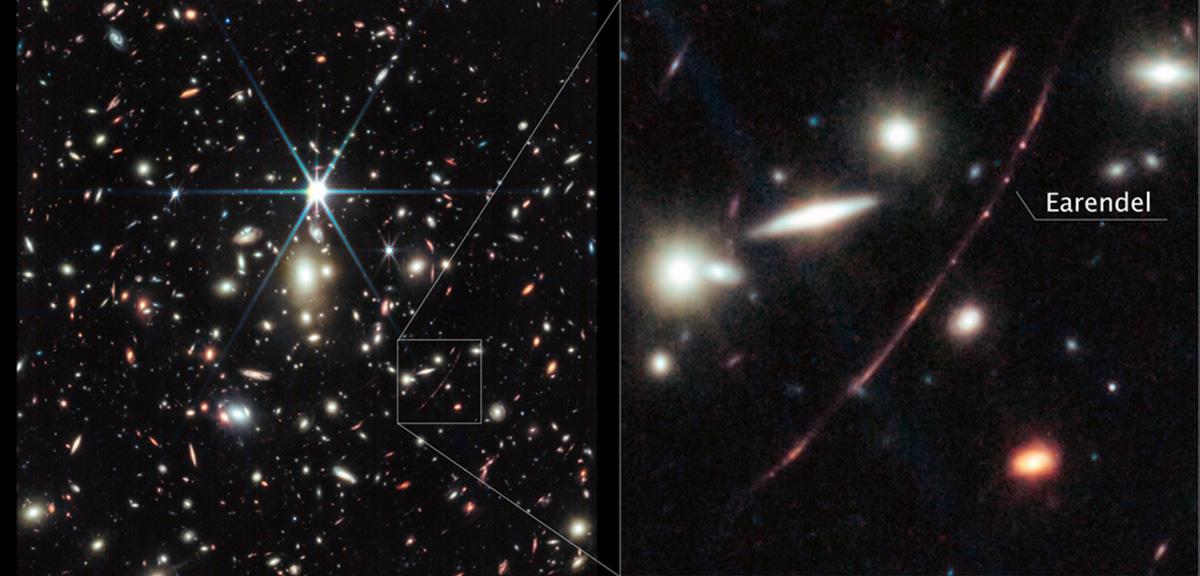The James Webb Space Telescope (JWST) was launched into space in a rocket on Christmas Day 2021 and has been in orbit one million miles above the earth for 1 ½ years, probing the edge of human understanding of the universe, looking for and finding new and exciting things.
The famous scientist Galileo was the first person to use a telescope to look at the night sky, over 500 years ago. He saw for the first time what the human eye could not see by itself: mountains on the moon, Saturn’s rings, and the planet Jupiter with moons circling around it. This helped to shake the foundations of the view that had prevailed for thousands of years that the earth was the center of all things. For this, Galileo was threatened with torture and forced by the church authorities to publicly recant and deny what he had seen.
Galileo’s telescope was small and simple, and you could hold it in one hand. The James Webb Space Telescope is something else. It is so sensitive that it could detect the heat of a bee on the moon. It is in orbit high above the earth, far above things like air or the earth’s heat, which would distort its images. Even in space, some of its instruments are cooled to nearly absolute zero temperature so that heat from the distant sun doesn’t affect what it is observing. All of this makes it possible for the JWST to push the boundaries of what humans can observe—it gathers radiation from the very earliest stars and galaxies, looks at the planets in our own solar system in new ways, is finding intriguing traces of what could be signs of life on other planets, and much more. Here, its giant mirror is tested on the ground before it was sent into space:
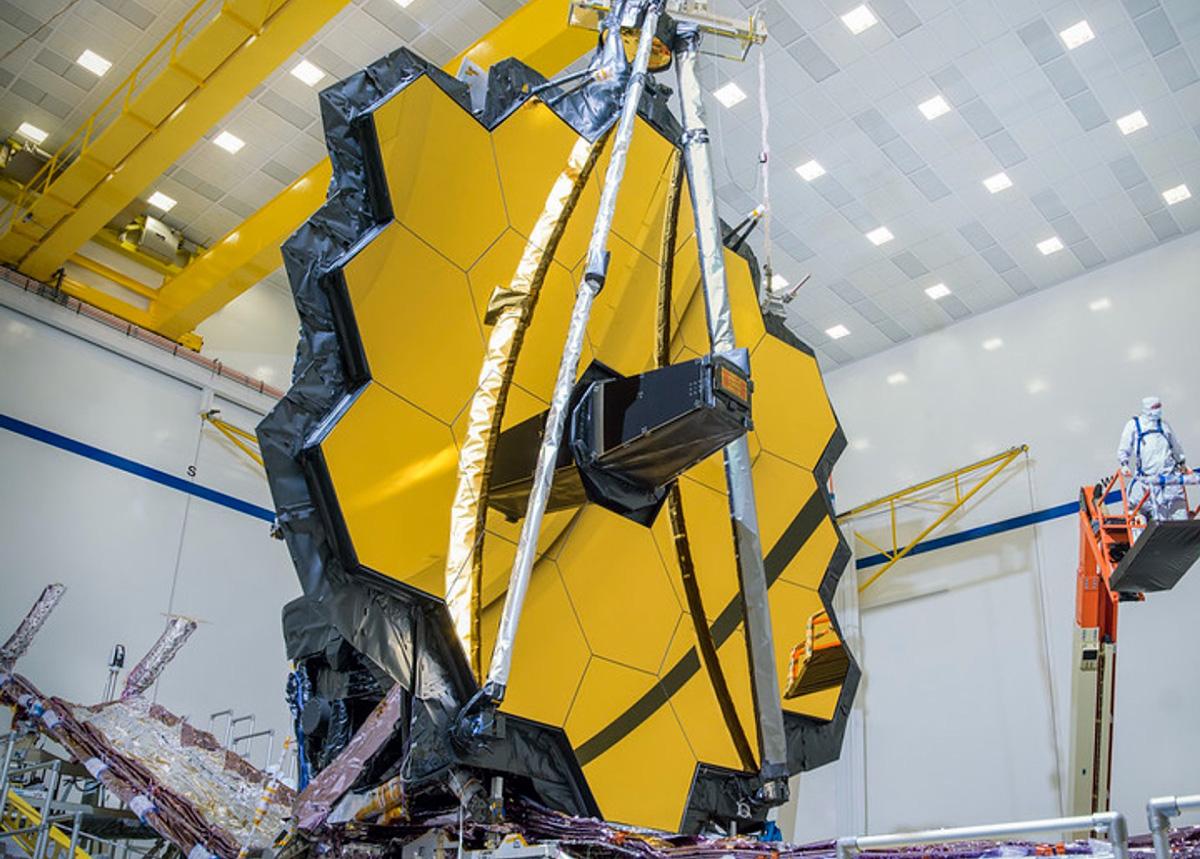
Testing the giant mirror on the Webb Telescope on the ground before its launch into space. Photo: NASA
This space satellite is run by a few major capitalist-imperialist countries, headed by the U.S.—a society in which science and scientific thinking is under fierce attack, and in which understanding of science and of important discoveries are kept away from the broad masses of people and made accessible only to a small section of society. But you can see in what the JWST has discovered something of what human beings are capable of, and what science could do and be, as part of a fundamentally different society brought into being through communist revolution.
People look at what religion calls “the heavens.” They look at the stars, the galaxies. They can see a small part of the vastness of the universe, and they can imagine the greater vastness of the universe. Or they can look on a small scale, look with a microscope and see a small microbe or whatever, and be amazed by what goes on internally within that. They can ponder the relation between what you can see with a microscope and what you can see with a telescope. This is an essential quality of human beings. Human beings will always strive for this. Far from trying to suppress this, or failing to recognize it, we can and should and will give much fuller expression to it.
Communism will not put an end to—nor somehow involve the suppression of—awe and wonder, the imagination, and “the need to be amazed.” On the contrary, it will give much greater, and increasing, scope to this. It will give flight on a much grander scale to the imagination, in dialectical relation with—and in an overall sense as a part of—a systematic and comprehensive scientific outlook and method for comprehending and transforming reality.
—Bob Avakian, BAsics 4:30
Here are some images from the JWST which give a sense of the discoveries it is making and how scientists are probing the universe.
Supernovas—Where the Atoms That Make Up Our World Are Forged
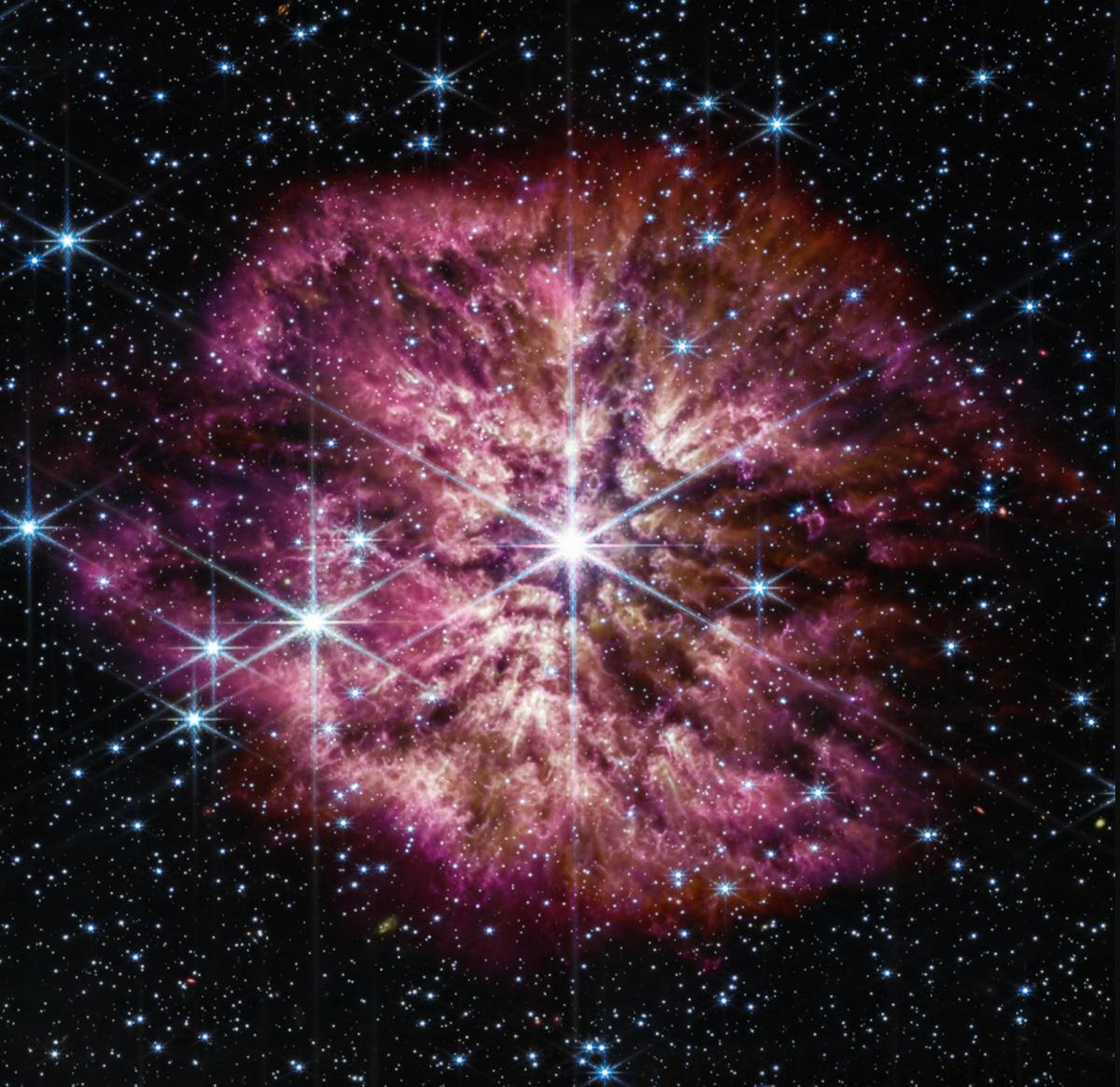
Wolf Rayet star Photo: NASA
This image from JWST is a rare picture of what is called a Wolf-Rayet star. This star is going to explode in what is called a supernova, but this picture captures it before it explodes, when, for a brief time, it sends out clouds of dust and gas before blowing apart. Only some of the most massive stars become Wolf-Rayet stars.
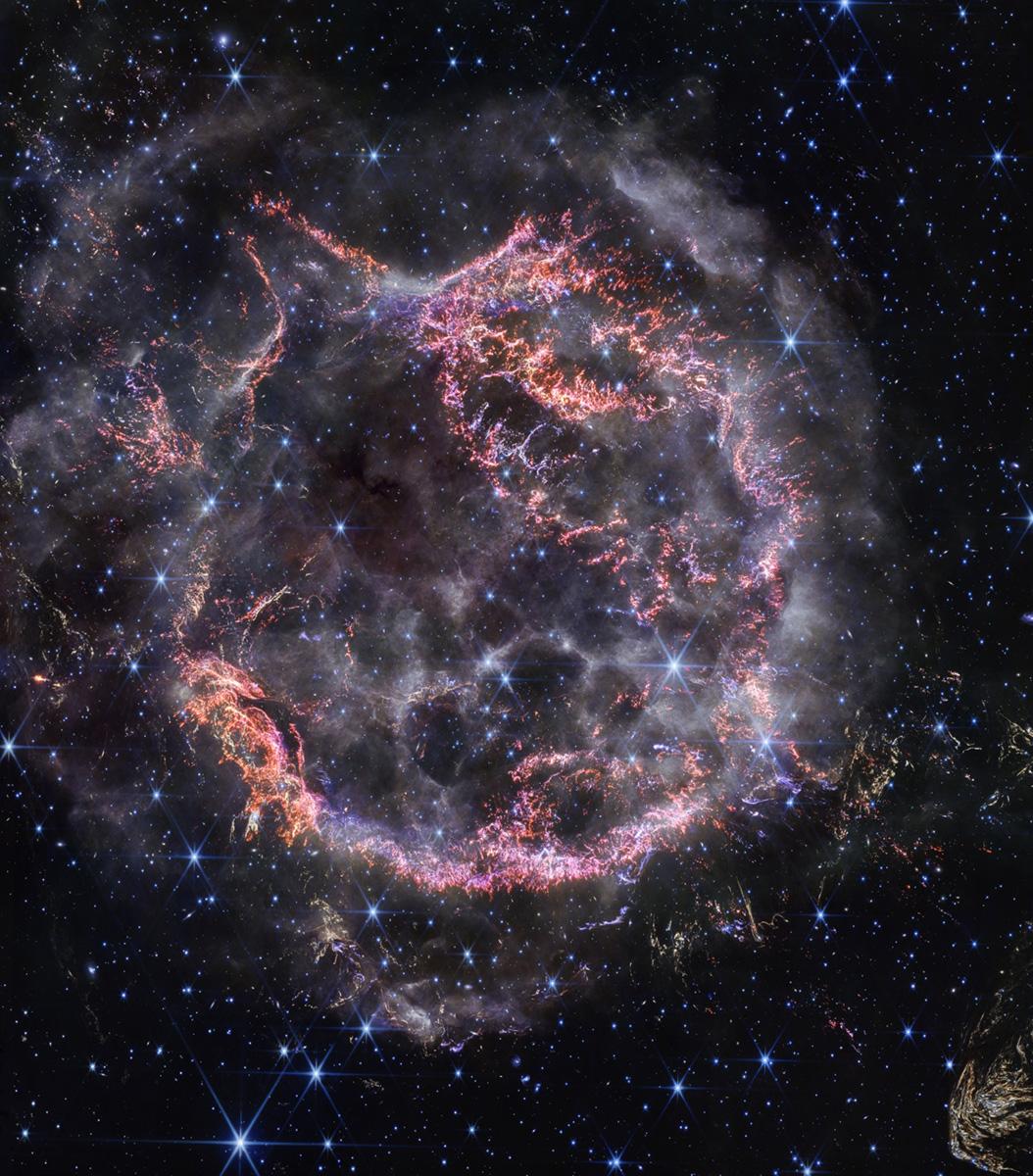
Supernova remnant Cassiopeia A Photo: NASA
This image is of Cassiopeia A, the remnants of a supernova. What is in this image is 60 trillion miles across. The exploded star is sending sulfur, oxygen, argon, and neon and dust out into space, which will ultimately become new stars and planets. What Galileo learned—that the earth is not the center of the universe—has been immensely deepened since his time. Not only is the earth not the center, but the universe itself has changed dramatically over time. The very early universe was extremely dense and hot right after what astronomers call the “big bang”—and as it cooled, the first atoms emerged, but these were only of hydrogen and helium—the smallest and simplest of atoms. All of the other atoms—oxygen, carbon, iron, etc., that make up the air we breathe, the ground we stand on, life on earth, and ourselves—were created in supernova explosions like Cassiopeia A (and a few in other kinds of cosmic explosions), and then spread throughout the universe in the form of dust and gas. The creation of atoms in supernova explosions is still going on today. This image from JWST is far more detailed than anything before, and enables scientists to understand more deeply how and why the star exploded.
Planets and Exoplanets
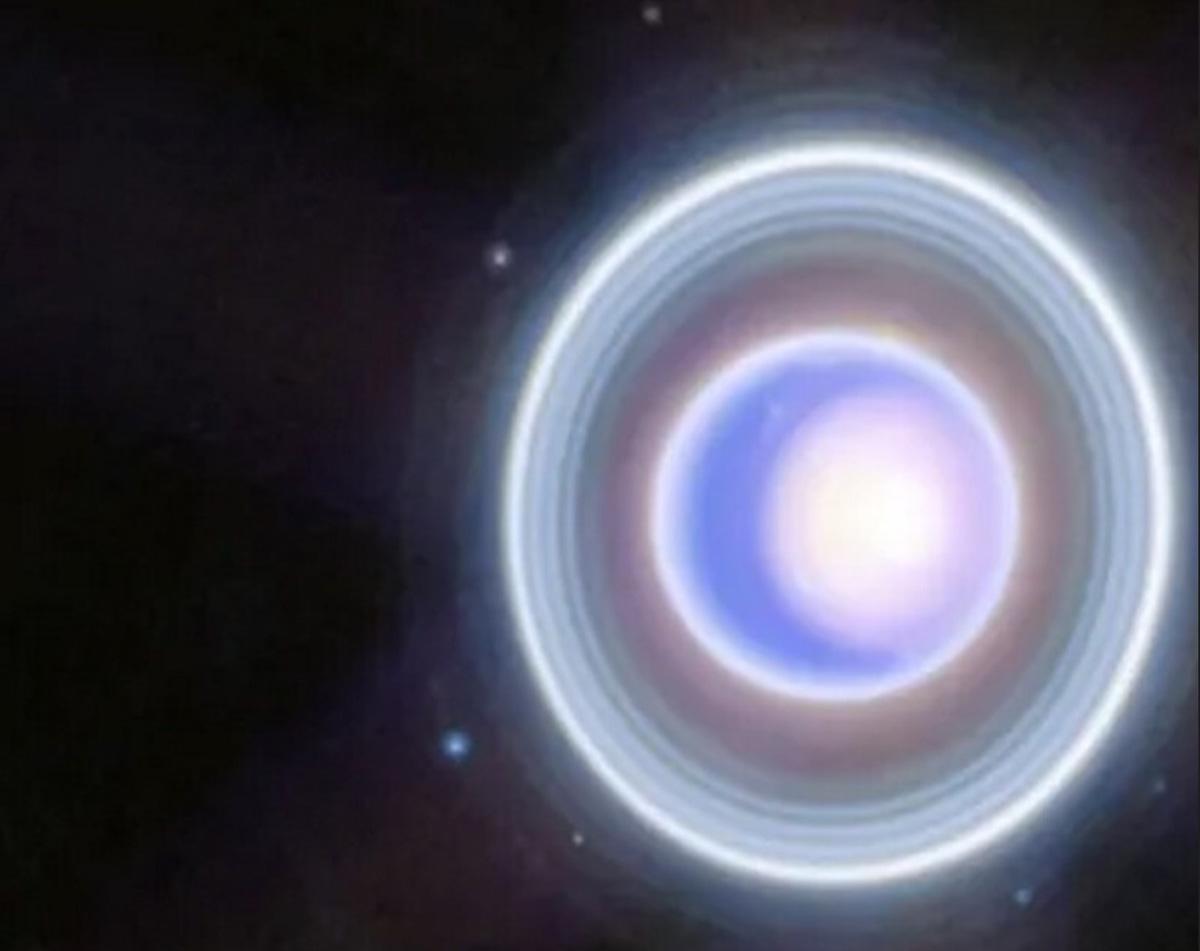
James Webb picture of Uranus. Photo: NASA
This is an image from the JWST of the planet Uranus in our solar system, and you see some of its 27 moons around it. This picture brings out features of Uranus not seen before. NASA, the government agency which runs the James Webb Telescope, says about this picture: “Surprise! Uranus has rings!” Uranus is similar to many of the planets being discovered by astronomers outside our solar system, and learning more about Uranus can help scientists understand more about these exoplanets (planets outside our solar system), and aid the search for life in the universe.
For contrast, and to show starkly what the JWST captures compared to past images, here is an image of Uranus taken in 1986 by the Voyager 2 spacecraft which flew near Uranus:

Uranus taken by Voyager 2.
The Earliest Stars
This is an image of Earendel, the most distant star yet observed. The JWST found it is one million times brighter than our sun. Astronomers using JWST are searching for that first generation of stars that emerged in the universe after the “big bang,” when the only atoms were hydrogen and helium. Earendel is not thought to be from that first generation, but it is very distant—the light from Earendel has traveled 12.9 billion years to reach us.
Earendel can only be seen by JWST because there is a massive cluster of galaxies between Earendel and the JWST. Huge amounts of matter warp space, and slow down time, and this also bends light. A massive cluster of galaxies, with immense gravity, can act as a “gravitational lens.” This is like a giant magnifying glass in space, making it possible for the JWST to “see” Earendel. The galaxy that Earendel is in appears in this image as a stretched-out line—this is because of distortion caused by the gravitational lens. This is one example of how scientists are using the combination of the incredible sensitivity of JWST combined with the effects of such “gravitational lenses” to capture images of the earliest stars, galaxies, and black holes.
The Search for Life Beyond Our Planet
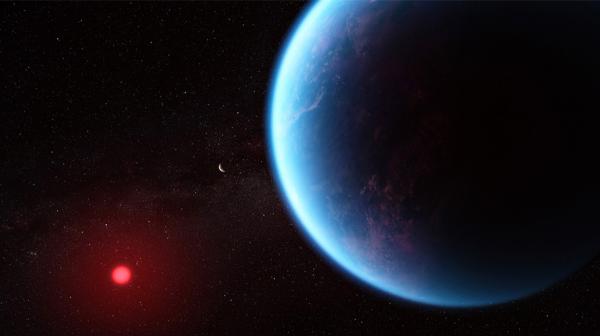
Artist rendering of exoplanet K2-18 b. Photo: NASA
This is an artist’s image of the exoplanet K2-18 b, which is in what is called the “habitable zone,” neither too far nor too close to its sun, so life might be possible there. (The small red-orange circle is the planet’s sun.) One of the missions of the JWST is to look for signs of life on exoplanets. The Webb telescope looked at light passing through the atmosphere of planet K2-18 b, when it crossed in front of its star. The JWST did what is called a spectroscopic analysis of that light—different molecules in the atmosphere leave different patterns in the light. With an instrument as powerful as the Webb, these patterns can be seen and deciphered even from very distant galaxies. The JWST found traces of carbon dioxide and methane, along with no ammonia, on K2-18 b. This is an exciting indication that scientists think might point to life on the planet! This is the first time this combination has been seen by science. The JWST has also found possible signs of a chemical called dimethyl sulfide (DMS) on K2-18 b, which on earth is created only by life.
The lead scientist on the team that made the discovery said: “[T]his hints at the core of the questions we have asked as a species for thousands of years. Why are we here? Are we alone? These are questions everyone, almost everyone, can be found asking at some point in their life. You look at the night sky, you wonder, are we alone?”
Astronomers for several decades have searched for and found planets outside our solar system—as of December 1, 2023, more than 5,500 exoplanets have been discovered around stars outside our solar system, and nearly 7,500 more may have been discovered but are waiting to be confirmed. But a very important question is whether life exists on these planets. The JWST has made big leaps in this search possible.
Finding life on other planets would have huge implications for us here on earth. We could learn a great deal about how life could emerge and start to evolve in places very different from earth—which would help us understand more deeply how life emerged and started to evolve here. We would know we are not alone in the universe!
Evolution—the scientific understanding that all of the immense variety of plants, animals and other life that exists on planet earth did not come about because a god created them all, but because life evolved through natural processes that produced changing kinds of life and new things that never before existed. Evolution is fundamental to life where ever it might exist. Ardea Skybreak speaks to important questions bound up with this in her book The Science of Evolution and the Myth of Creationism: Knowing What’s Real and Why It Matters:
We now know that our own human evolution as well as the evolution of all living things can be explained by entirely natural processes and requires no super-natural explanations. But will our ability to increasingly understand life without god leave us feeling in some way adrift and empty? Why should it? We still can, and should, be duly amazed, sustained, even humbled, by the recognition of the wonders of diversity and complexity that naturally evolving life can itself bring forth, and by both the limitations and ongoing potentials of our own humanity… Far from being a recipe for a grey, cold and passionless outlook, a truly materialist scientific method, systematically applied to uncovering the actual genuine wonders of the natural and social world, can uncork the imagination, the sense of purpose and the transformative consciousness and initiative of human beings in ways no reference to a presumed higher power ever could. Isn’t that an outlook worth striving for?
We Can See to the Edge of Time—But What About the Future of This Planet?
There is great beauty in the images from JWST, and deep questions addressed about how things got to be the way they are in the universe. We should, as Bob Avakian says, “be amazed”—looking at the unfolding universe over billions of years, the forging of the first stars and galaxies, the production of the elements that make planets and life possible in incredibly powerful explosions inside stars, and tantalizing signs of life on distant worlds.
And yet the instruments which enable humanity to see stars 12.9 billion years in the past are trapped within a social system in which privately owned networks of capitalist exploitation span the globe, exploiting billions of people and forcing 150 million children into child labor… a social system which brings down genocidal slaughter on whole nations, and even threatens nuclear war… a social system which is changing the climate of the earth and as a result starving millions and driving tens of millions from their homes… a system in which science is kept hidden from the majority of people, and people are trained not to think about the earth and how it could be a home for humanity and in which people could be caretakers of the planet, but instead are trained in religion, patriotism, and other unscientific beliefs, and trained—and forced—to see everything in terms of “me, me, me.”
The problem is NOT humanity, which has learned how to do extraordinary things even when trapped within the confines of insane and savage systems of exploitation. The problem is capitalism-imperialism—and this, however powerful it might seem, is just a social system which can and must be overthrown, and a whole new system, socialism moving on to communism, put in its place. A society and ultimately a world in which people are led and trained to put the planet and humanity first… a society and world in which people work together to overcome the trauma and all the oppression of the past… a society and world in which people are not lied to and kept away from the truth about reality, but in which science, the scientific method, along with poetry, art, and politics are opened up for all the people in society, and age-old barriers and prejudices are struggled against and cast aside. This is not a dream. This is the new communism developed by the revolutionary leader Bob Avakian.
What the James Webb Space Telescope is discovering IS amazing. It should lift our sights and help us shed the mental chains of this system, and fight for a whole new emancipated world.
Some Key Concepts in Astronomy
Big Bang: The current scientific theory of the origin of our universe is that it began 13.8 billion years ago in an event known as the Big Bang. The Big Bang started the universe we know with a massive expansion that led to our ever-expanding cosmos.
Galaxy and galaxy cluster: A galaxy is a large grouping of stars which is held together by gravity. A typical galaxy can have 100 billion stars. It is estimated that there are over 100 billion galaxies. A galaxy cluster is a group of galaxies held together by gravity.
The speed of light and looking backward in time: Light travels at a very fast but finite speed of about 186,000 miles per second. The distance light travels in a year is called a light year. For the very distant objects that the Webb telescope observes, for example, those that are 13 billion light years away, the light from those objects is also 13 billion years old. So, when the Webb makes images of them, the image shows what it was like 13 billion years ago.
Gravitational lens: Einstein showed that matter bends space, and so radiation like light or X-rays traveling through space is also bent. This bending of light makes it possible for a huge mass, like a galaxy or cluster of galaxies, to act as a lens, like a giant magnifying glass. A telescope can look at that huge mass and “see” what is behind the cluster, even billions of light years away. Gravitational lenses magnify, but also distort and twist, light.
Exoplanet: Our solar system is the group of planets, comets and other objects that revolve around our sun. An exoplanet is a planet that is outside our solar system. Most stars have more than one planet—there are more planets than stars in the universe.
Spectroscopy: Different atoms and molecules absorb and emit radiation (like light, X-rays, radio waves, infrared waves) in different ways, in different patterns. By studying the radiation from distant stars, from dust or atoms in space, or from planets, astronomers can see what atoms were there. For example, the JWST found carbon dioxide on the exoplanet K2-18 b—spectroscopic analysis of the radiation passing through the atmosphere of the planet showed the unique pattern made by carbon dioxide, a molecule made up of carbon and oxygen. If the analysis is done right, and sometimes these experiments have to be checked and rechecked, it shows that carbon dioxide is really there.
